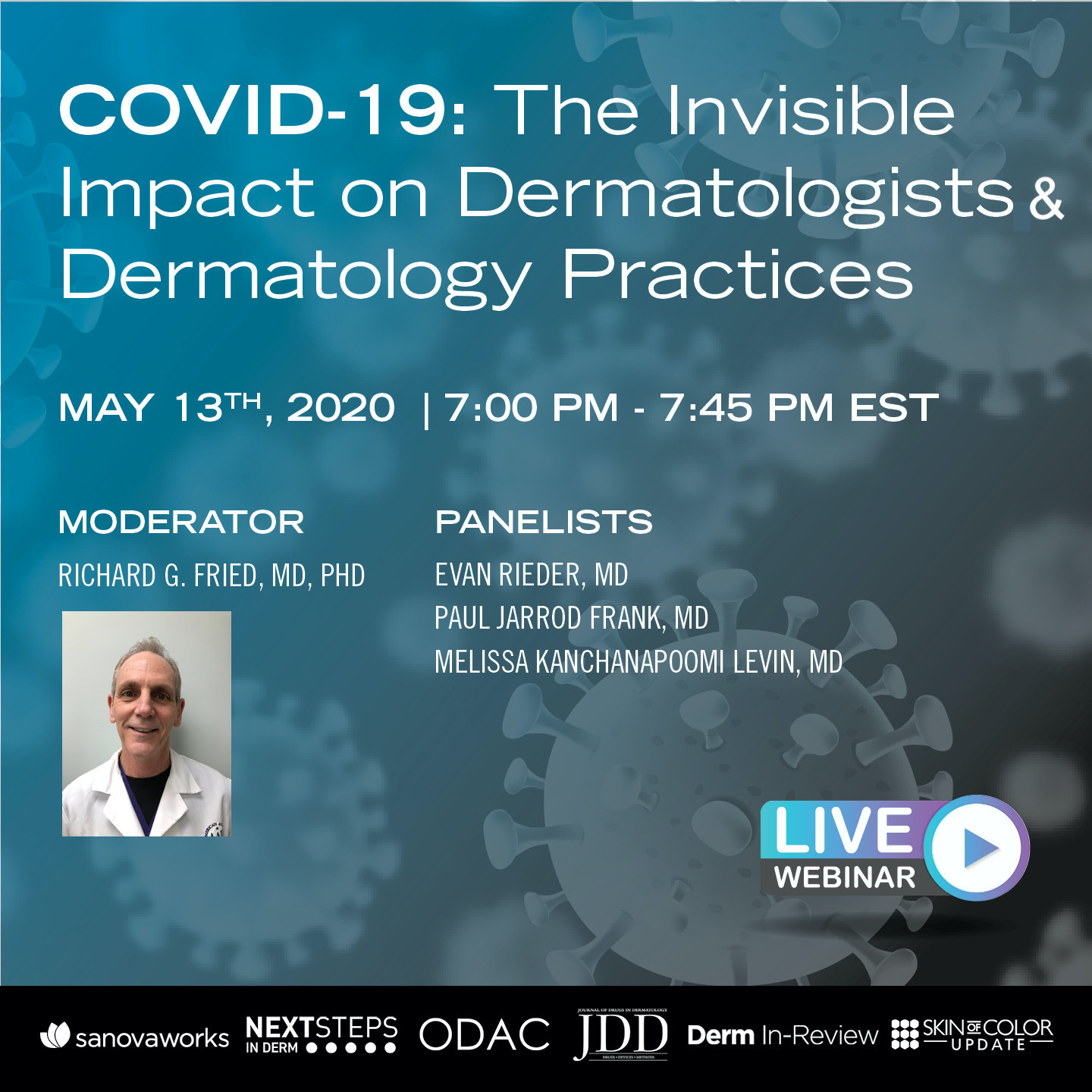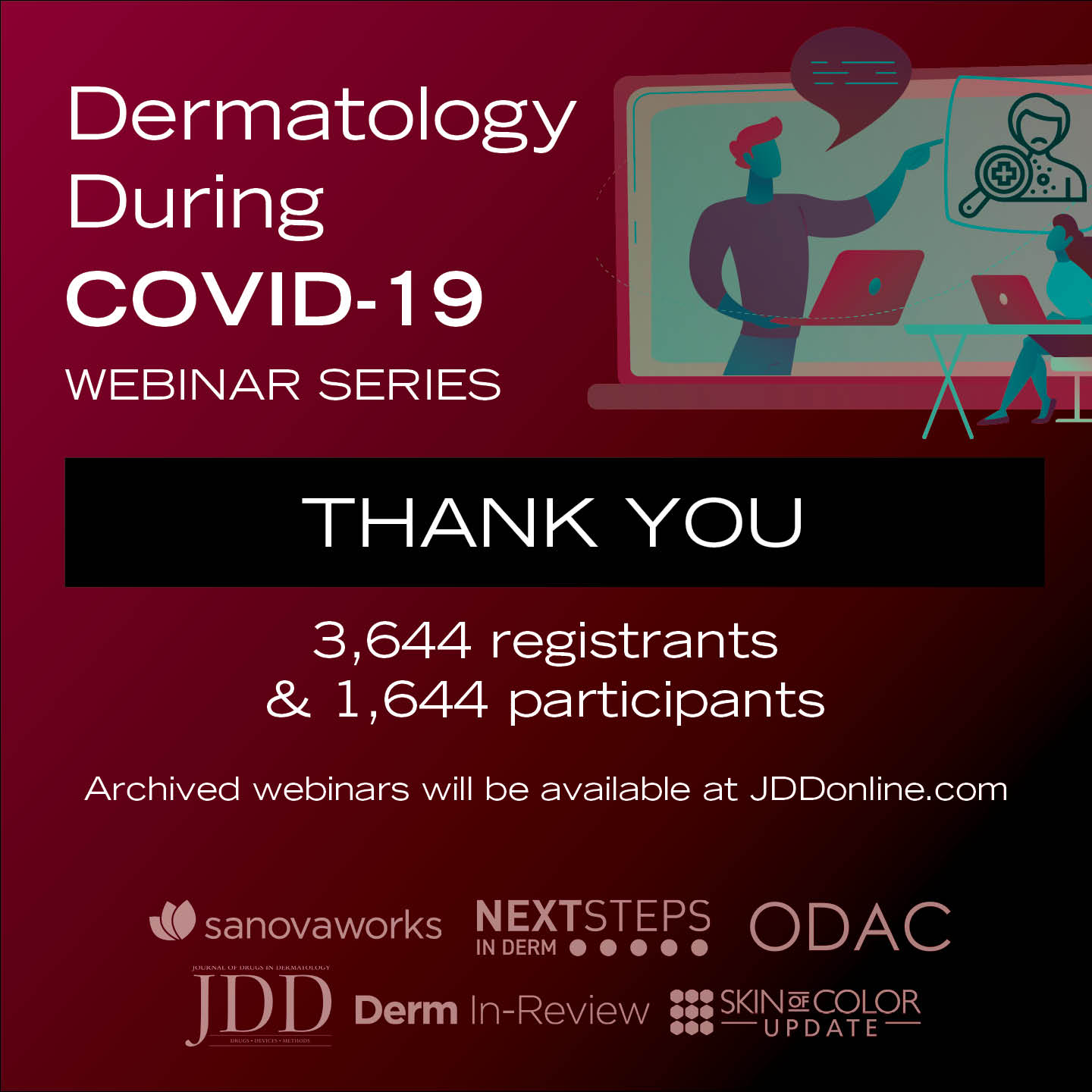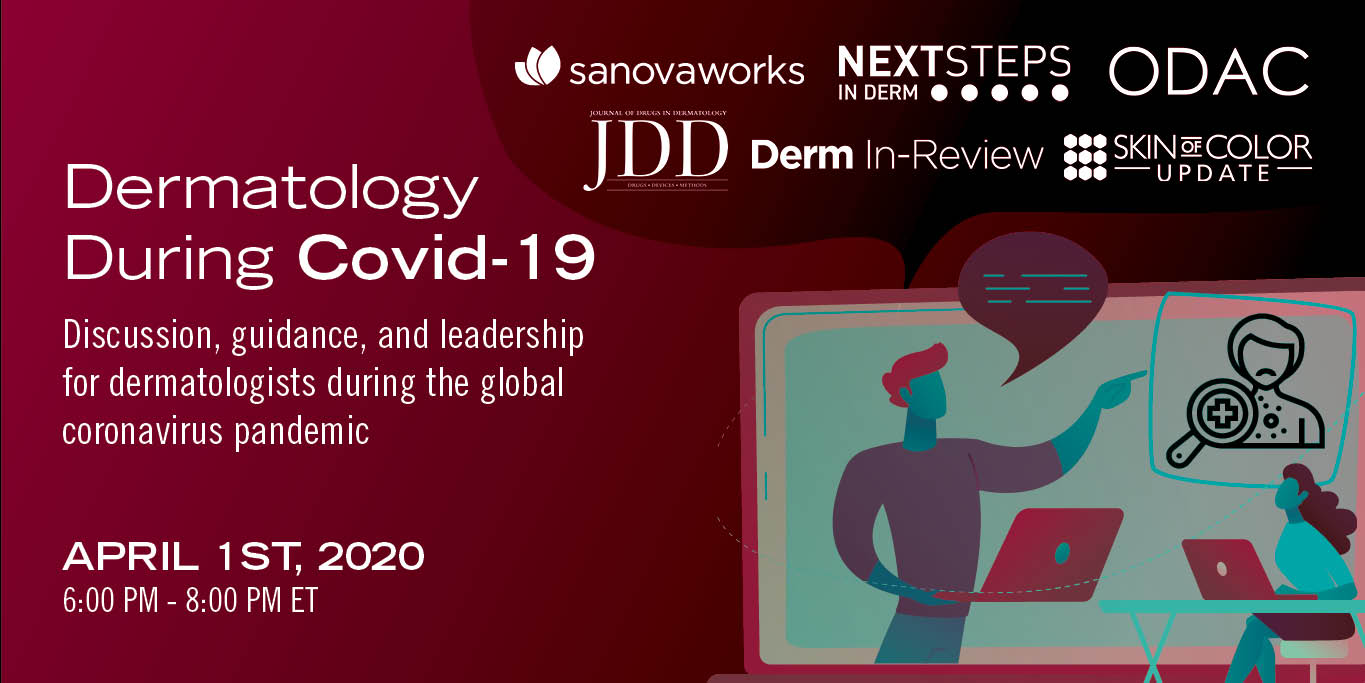Click here to view the on-demand recordings.
On April, 1, 2020, the Journal of Drugs in Dermatology (JDD) and SanovaWorks brands, including ODAC launched Part I of the webinar series: COVID-19: Urgent Dermatology and Aesthetic Issues for Dermatology.
Over the course of the 2 hours, Joel L. Cohen, MD and 6 different thought leaders joined the COVID-19 conversation, discussing the pressing questions that are on the minds of many dermatologists and providers in the country. The initial broadcast attracted 1,900 registrants and nearly 800 attendees comprised of physicians, residents, fellows, nurse practitioners and physician assistants. Attendees were interested and engaged throughout the entire 2 hours with a 76% average attentiveness and 72% average interest rating.
The on-demand broadcast has attracted over 500 registrants as of April 9th and is available on JDDonline.com.
On April 7, 2020, Part II of the webinar series was broadcasted: COVID-19: Your Questions Answered. Dermatology experts and thought leaders examined the legal and financial concerns of dermatology providers during the global coronavirus pandemic. Experts discussed furlough vs. layoffs; mortgage and rent relief programs; the CARES Act; the pros and cons of leveraging NPs or PAs for teledermatology and more. Then, hear questions answered by our panel of experts; discussed practical tips you can use in your practice right now; and how to move forward with patient care. Part II attracted 1,300 registrants with nearly 700 attendees. Attendees were engaged and interested throughout with an 82% attentiveness average and 75+% interest rating.
The on-demand broadcast of Part II will be available on April 11, 2020 on JDDonline.com.
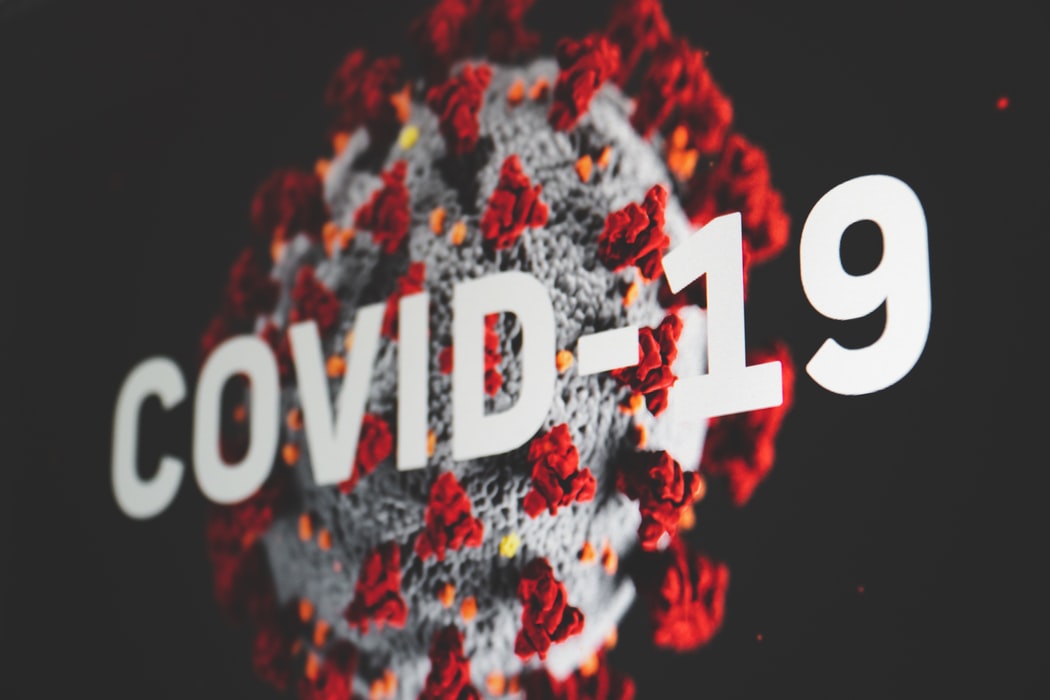
Source: Journal of Drugs in Dermatology
While the world lives under the shadow of the novel coronavirus (COVID-19) pandemic, dermatologists wonder if the current situation calls for a temporary change in the management of skin conditions.
Immunosuppressive drugs are used ubiquitously in the modern treatment of inflammatory and autoimmune skin diseases like psoriasis, bullous diseases, connective tissue diseases, and many others. Treatment of these conditions is based on the suppression of the patient’s immune system using steroids, steroid-sparing drugs, and biological agents.1
While the effects of the novel coronavirus on the body and its immune system are still being studied, there is overwhelming evidence that the virus could directly or indirectly affect the immune system. In one study, lymphocytopenia was reported in 83.2% of the admitted patients and might be associated with a worse prognosis.2In another study, a steady decline in the lymphocyte counts was recorded in a group of patients who did not survive the infection.3
While the coexisting comorbid medical conditions (such as diabetes or heart disease) are considered as independent predictors of an adverse outcome of the novel coronavirus infection,4 it could be assumed that the chronic inflammatory and autoimmune skin diseases like psoriasis by themselves might imply an additional risk factor of developing more serious symptoms of the novel virus due to their chronicity and effects on the immune system.5
The use of immunosuppressive to treat these conditions can amplify this effect, and it might leave the patient vulnerable to more serious complications should an infection with the novel coronavirus be established. Hence, it may be wise to restrict temporarily the use of immunosuppressive agents including systemic steroids, steroid-sparing agents, and biologics in dermatology daily practice until more evidence is available about their safety in the current pandemic.6As a relates point, the International Psoriasis Council declared an urgent statement on March 11, 2020 that the physician should be alert to the potentially harmful effects of COVID-19 infection on patients with psoriasis and to immediately discontinue or postpone immunosuppressant medications for psoriasis patients diagnosed with COVID-19 disease.7
This webinar was previously recorded on April 1st, 2020 and is now available on demand. Click here to access the on-demand recording.
Join Dermatology Leadership Discussion of COVID-19
ODAC and JDD invite you to attend a webinar panel to provide discussion, guidance, and leadership for dermatologists and dermatology practices during the global coronavirus pandemic.
Over the course of the 2 hours, 8 different thought leaders will join the conversation, discussing questions that are on the mind of many dermatologists in the country. Click here to register.
MODERATOR
Joel L. Cohen, MD (Director, About Skin Dermatology & Associate Clinical Professor, University of California at Irvine)
AGENDA
6:00-7:00PM
Neal Bhatia, MD (Vice President-elect of the AAD & Director of Clinical Dermatology, Therapeutics Clinical Research)
Adam Friedman, MD (Professor and Interim Chair of Dermatology, GW School of Medicine & Health Sciences)
William D. Humphries (President, Ortho Dermatologics)
Mark Kaufman, MD (Associate Clinical Professor, Icahn School of Medicine at Mount Sinai)
7:00-8:00PM
Sue Ellen Cox, MD (Founder, Aesthetic Solutions)
Kavita Mariwalla, MD (Founder, Mariwalla Dermatology)
Carrie Strom (Senior Vice President, US Medical Aesthetics at Allergan)
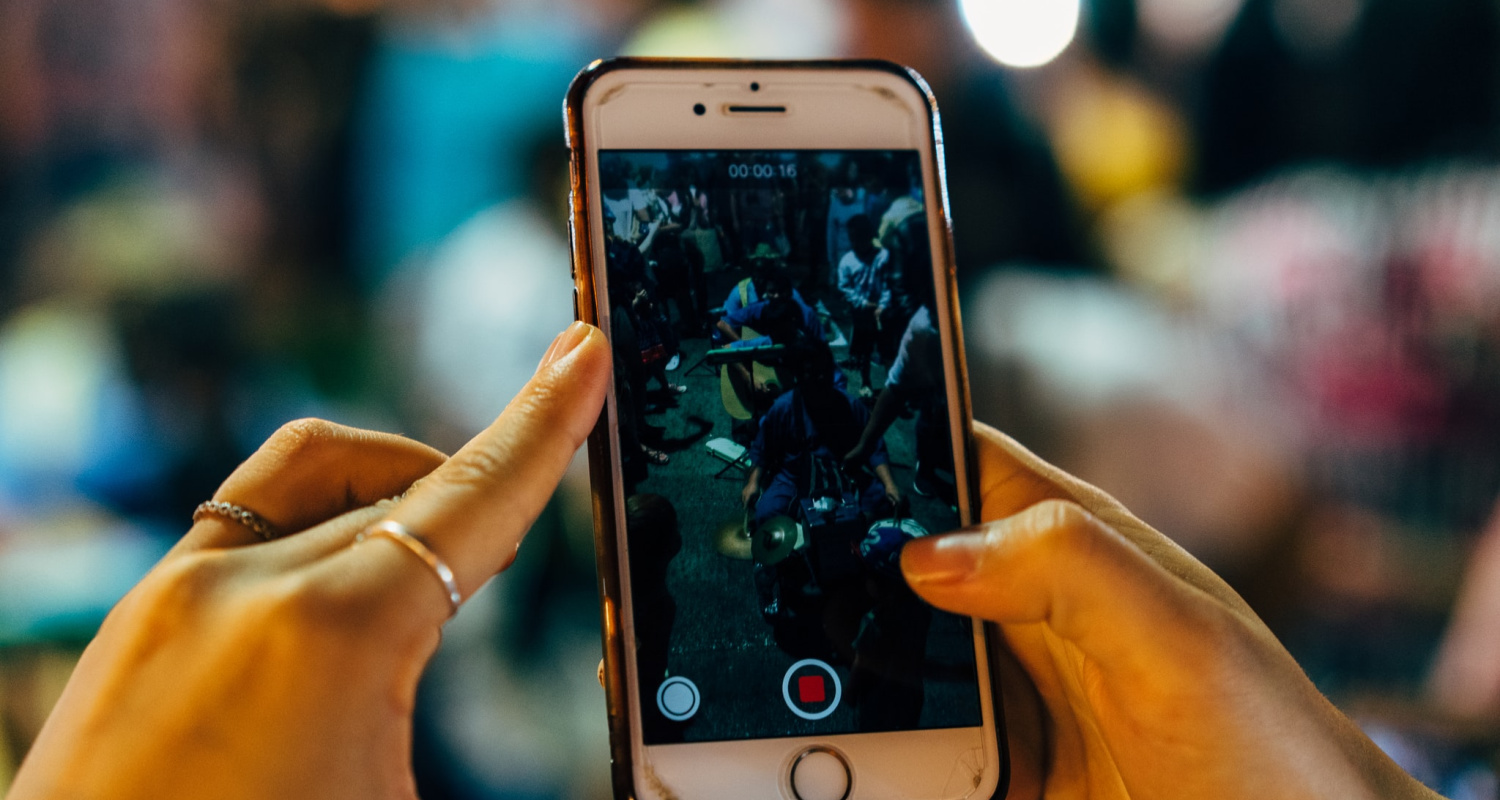
Source: ODAC Dermatology Conference’s Parent Company, SanovaWorks
NEW YORK, (Mar. 26, 2020) – Shelley Tanner, SanovaWorks CEO/President
In the wake of COVID 19, I wrote a article about the Top Immediate Needs of a Remote Employee
Regular communication through video conference calls was at the top of my list. I asked the team what their thoughts were and received a great response from Nick.
Nick Gillespie, Assistant Publisher
Use video conference tools, not the phone.
Sometimes staff can feel that it’s an imposition, but the quality of meetings for those participating via video is infinitely better than just via phone
I would say the most important tip is to embrace the video component of remote working.
People quickly become used to the video interface, to the point where it becomes no different from meeting face to face in the office.
Gaging facial expressions and body language is very important for effective communication.
I think if you are a manager in a company, you should make video attendance mandatory for all.
Some links about the benefits of face to face meetings (even remote ones):
https://timemanagementninja.com/2012/10/5-reasons-why-meeting-face-to-face-is-best/
https://sebastiancorp.com/10-reasons-video-conferencing-is-better-than-a-conference-call/

Source: Next Steps in Derm
Each week, Next Steps in Derm will be compiling the top news and updates surrounding COVID-19 to keep you up-to-date and informed.
HIPAA Compliance During COVID-19 Pandemic
Learn what information can be shared about individuals who have contracted COVID-19, those suspected of exposure to the 2019 Novel Coronavirus, and those with whom information can be shared.
For any questions you have related to the response to HIPAA compliance during coronavirus crisis call (800) 231-4096.
JDD CME library offers virtual learning during COVID-19
The JDD CME library is now updated to accommodate a growing demand for online CME resources. We expect this demand to grow in light of the cancellation of some medical meetings due to the global COVID-19 situation. Access the CME library here.
Medicare Telemedicine Health Care Provider Fact Sheet
The American Academy of Dermatology strongly recommends that patients should not stop biologic therapy without consulting their physicians. Read their interim recommendations here.
AAD Coronavirus Resources
Managing your practice through the COVID-19 outbreak
American Medical Association (AMA) COVID-19
Resource Center for Physicians
AMA Physician’s Guide to COVID-19
- Prepare your practice
- Address patient concerns
- Answer your most pressing questions
COVID-19: Frequently asked questions
- Patient-physician relationship questions
- Clinical questions
- Practice management questions
- Ethical Questions
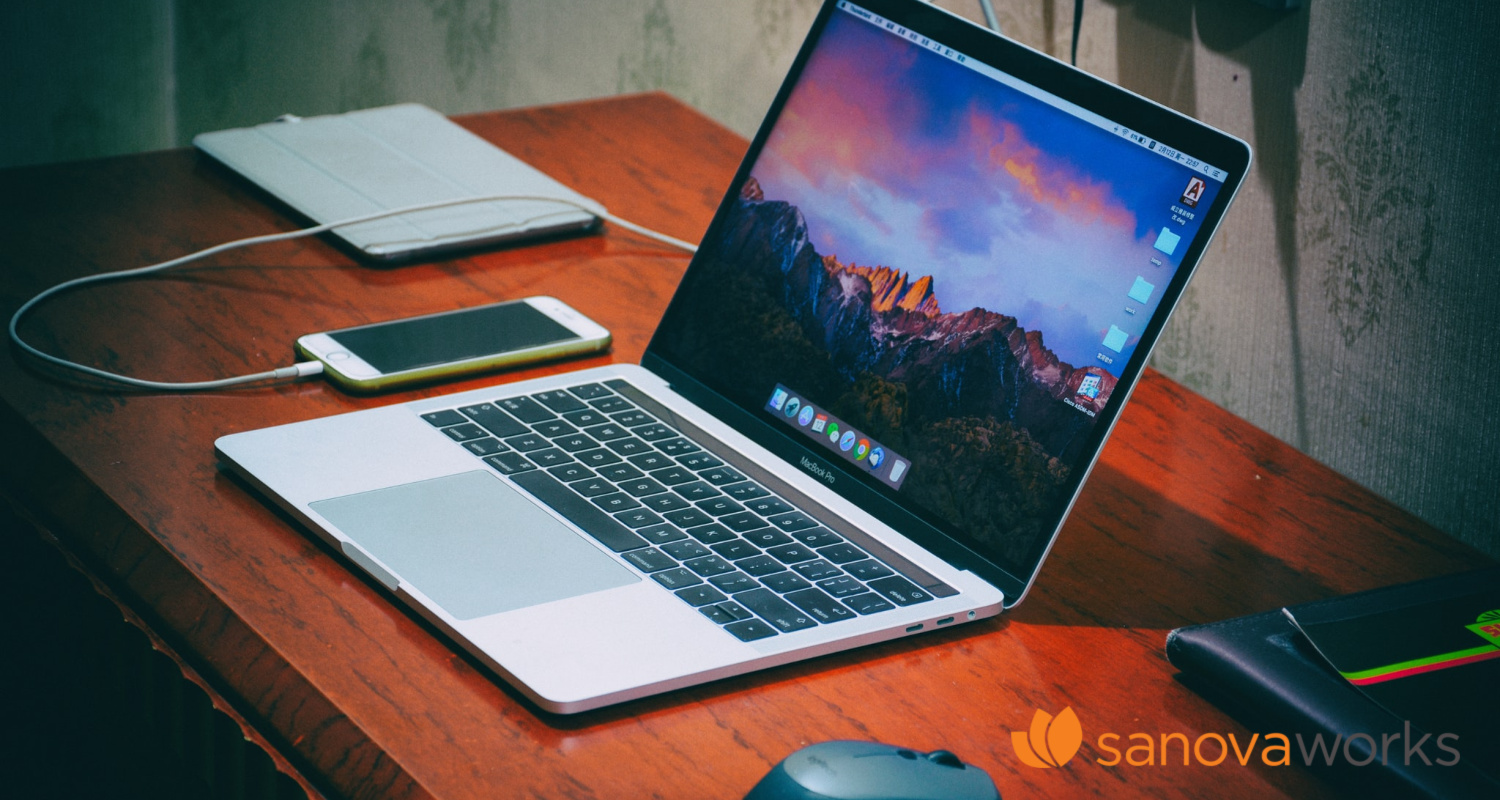
Source: ODAC Dermatology Conference’s Parent Company, SanovaWorks
NEW YORK, (Mar. 23, 2020) Signe Pihlstrand, Vice President, SanovaWorks
In the wake of COVID-19 and the need for social distancing, many companies are having their staff work from home, and a great portion of them don’t have a routine remote policy or have remote processes set up. SanovaWorks has been successfully 100% remote for over six years now, and we gave ourselves many months of preparing, the better part of a year, before launching our remote work culture. These companies unfortunately don’t have that luxury and need to keep their workforce productive and the wheels rolling with an abrupt start to their remote experience. When I think about the most important things a company can do to lay the right foundation for their remote procedures, the plan for how you will communicate regularly is the first thing that comes to mind.
Working remotely requires clear communication and clear expectations.
If your team isn’t used to working remotely, you can’t assume that everyone will be on the same page about how to connect. Setting up defined guidelines for when and how you will communicate is so important.
- When – This has the tendency to go both ways: It’s not productive to be bombarded with IMs and emails throughout the day, and radio silence can leave you wondering if anything is getting accomplished. Set up and communicate a clear plan for when you expect to hear from your staff, or colleagues – for instance, a 15-minute touch-base call every morning, emails returned within 24-hours, or maybe a daily end-of-day report from your staff.
- How – Pick the ways that your team will communicate and get everyone on the same tools. You don’t want to have to check numerous places for messages. Plus, decide what is communicated by each. Short, occasional messages are best for IMs, while longer messages can be via email – while longer yet should be done in a conversation by video chat.
These ideas may seem obvious, but if not set up to make sure everyone has the same idea about what communication looks like, it can really wreck productivity. If everyone is left to their own devices, you could be fielding phone calls, texts, IMs, video chats, and emails from whatever program someone has on their phone or laptop, at all times of the day, or not at all. Remote working requires its own set of procedures, just like you have at the office.
At SanovaWorks we train everyone on our designated tools and procedures and make it a priority to use video chats whenever possible for the best communication and team member connections!

NEW YORK (Mar. 13, 2020) – A Note from Shelley Tanner, SanovaWorks CEO/President
First and foremost, in light of the rapidly evolving global COVID-19 situation, we hope that you and your family are safe and healthy. We send companywide thoughts and prayers to the individuals, families, and other groups who have been impacted by this situation, and hope that things will improve very soon.
While many things are uncertain surrounding this virus, as an organization, SanovaWorks believes in taking action early. We are dedicated to providing the best care and support we can to all our employees and business partners.
We have the extremely good fortune to be functioning already as a virtual company and because of this we hope to be able to provide support and resources to our entire network who might not have the experience we have. Please check our blog for our tips and recommendations for transitioning to and being successful in a remote work environment:https://sanovaworks.com/2020/03/11/top-immediate-needs-of-remote-employees/
In addition to this, in order to protect our teams and others, until further notice, we have issued a complete restriction on all business-related travel. While the CDC has not placed restrictions on domestic travel, they have recently posted travel warnings on their website: https://www.cdc.gov/coronavirus/2019-ncov/travelers/travel-in-the-us.html?mod=article_inline
The CDC also provide general recommendations that we should all be following to prevent the spread of this disease:https://www.cdc.gov/coronavirus/2019-ncov/about/prevention.html
We will be working diligently as teams to connect with many of you so that we can share some very interesting ways to accomplish our results in this new, virtual environment. We have many years of experience transitioning traditional programs to digital programs, and launching successful virtual programs. Because we are already positioned as a remote company that produces virtual programs, we hope that we are able to support your own initiatives and bridge the gap this global situation has caused.
And last but not least, with a shout out to Jim Collins who introduced me to the Stockdale Paradox in his book Good To Great, we all need to look squarely at the facts, but have confidence that together we will prevail, as we balance realism with optimism.
Together.
Shelley and the entire SanovaWorks Team

Source: ODAC Dermatology Conference’s Parent Company, SanovaWorks
NEW YORK (Mar. 11, 2020) – A Note from Shelley Tanner, SanovaWorks CEO/President
SanovaWorks transitioned into a 100% virtual company at the end 2012 at the same time press was reporting market leaders like Yahoo and Best Buy stopped all remote work at their companies. To the outside world, it seemed like we were making a crazy decision, heading in the opposite direction from global brand in terms of office culture and environment. We were convinced of the many benefits, so without hesitation we transitioned from two floors of a small office building on Park Avenue South in Manhattan, to a completely remote workforce.
I realize that due to the Coronavirus outbreak many companies are forced to transition some or all of their teams into remote teams without a solid plan, and so I felt compelled to share some of my thoughts on this matter.
The main things remote employees need in the short term are:
- Access to information immediately
- Regular communication
- Clear visibility of priority and goals
For this reason, I am including some of my “must-haves”:
- Use video conference tools, not the phone. It take more internet bandwidth, but it provides a more engaged experience of meetings. If you don’t know what I’m talking about watch this live enactment of a conference call by phone: https://www.youtube.com/watch?v=DYu_bGbZiiQ
- Use online project management tools for collaboration and project tracking. We use Wrike.com but there are many other options like Asana or Basecamp.
- Use online file storage for easy access to documents. We use Egnyte, but there are options like Dropbox and Google also.
- Ask for feedback. Don’t be afraid to ask what people think. Communicate that this is new and you are figuring it out, but want to support your teams and accomplish results in this new environment. Your teams will give valuable insight into accomplishing results.
- Commute time turns into connect time: With a remote culture – everything can feel like a meeting. Be prepared for a feeling of meeting fatigue and get out ahead of it making meetings meaningful with clear agendas and timekeeping, etc.
If anyone has specific questions please comment on the Linked In post or direct message me and if I can’t answer, I will ask one of my extremely competent virtual team.
Best to all during these challenging times,
Shelley
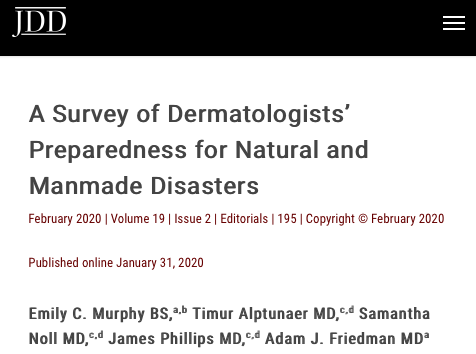
Source: George Washington University, ODAC and JDD
A new study from the George Washington University found that many dermatologists are unprepared to respond to biological disasters and that the specialty would benefit from formal preparedness training.
WASHINGTON (Jan. 30, 2020) — The dermatology community is inadequately prepared for a biological disaster and would benefit from a formal preparedness training program, according to a study from the George Washington University (GW). The article is published in the Journal of Drugs in Dermatology.
Natural and man-made disasters can cause a range of dermatologic conditions due to environmental exposures, such as secondary infections following a flood, irritation from blistering agents used in chemical warfare, and acute and chronic effects of cutaneous radiation syndrome. A 2003 survey revealed that 88% of dermatologists felt unprepared to respond to a biological attack — this new survey shows that the need for training still exists.
“Recognizing and diagnosing the conditions that can arise following a disaster requires diagnostic acumen, knowledge on reporting, and short- and long-term management strategies,” said Adam Friedman, MD, interim chair of the Department of Dermatology at the GW School of Medicine and Health Sciences and senior author on the study.
This current survey from an interdisciplinary team of dermatology and emergency medicine researchers, led by Emily Murphy, a research fellow in the GW Department of Dermatology, examines whether the field of dermatology has advanced in its bioterrorism preparedness.
The survey, disseminated via the ODAC Dermatology, Aesthetic & Surgical conference listserv, found that only 28.9% of respondents received training in disaster preparedness and response. The respondents to the survey frequently commented that they felt dermatologists should be prepared for bioterrorism-related cutaneous diseases, such as anthrax or smallpox-related diseases, as well as infections resulting from natural disasters.
Similar to the 2003 survey, the authors found that few dermatologists received adequate bioterrorism preparedness training. Even among those who had reported training, many indicated they felt ill prepared to manage patients affected by disasters, especially biological attacks and nuclear or radiological events.
“While few respondents to the survey were trained in disaster preparedness, it is encouraging that 75% reported that it should be included in dermatology training,” Friedman said. “It is a necessary tool to advance the field.”
James Phillips, MD, section chief of disaster and operational medicine in the GW Department of Emergency Medicine, director of the GW Disaster Medicine Fellowship, and co-author on the study, agreed: “My fellows and I found great value in partnering with our dermatology colleagues for this project. It is my firm belief that, while disaster medicine and emergency management primarily fall within the scope of emergency medicine and trauma surgery, education, and training for other specialties is of great value and is virtually unexplored. In an increasingly complex disaster environment, we welcome such research collaborations with other GW specialists.”
###
The article, titled “A Survey of Dermatologists’ Preparedness for Natural and Man-made Disasters,” is published in the Journal of Drugs in Dermatology and can be found at jddonline.com/articles/dermatology/S1545961620P0016X/1.

